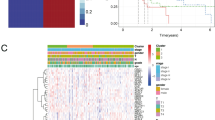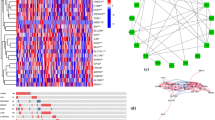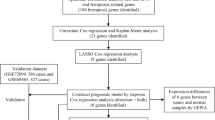Summary
Background: The purpose of this study was to identify ferroptosis-related genes (FRGs) associated with the prognosis of pancreatic cancer and to construct a prognostic model based on FRGs. Methods: Based on pancreatic cancer data obtained from The Cancer Genome Atlas database, we established a prognostic model from 232 FRGs. A nomogram was constructed by combining the prognostic model and clinicopathological features. Gene Expression Omnibus datasets and tissue samples obtained from our center were utilized to validate the model. The relationship between risk score and immune cell infiltration was explored by CIBERSORT and TIMER. Results: The prognostic model was established based on four FRGs (ENPP2, ATG4D, SLC2A1 and MAP3K5), and the risk score was demonstrated to be an independent risk factor in pancreatic cancer (HR 1.648, 95% CI 1.335–2.035, p < 0.001). Based on the median risk score, patients were divided into a high-risk group and a low-risk group. The low-risk group had a better prognosis than the high-risk group. In the high-risk group, patients treated with chemotherapy had a better prognosis. The nomogram showed that the model was the most important element. Gene set enrichment analysis identified three key pathways, namely, TGFβ signaling, HIF signaling pathway and the adherens junction. The prognostic model may be associated with infiltration of immune cells such as M0 macrophages, M1 macrophages, CD4 + T cells and CD8 + T cells. Conclusion: The ferroptosis-related prognostic model can be employed to predict the prognosis of pancreatic cancer. Ferroptosis is an important marker, and immunotherapy may be a potential therapeutic target for pancreatic cancer.









Similar content being viewed by others
Data availability
All data generated or analyzed during this study are included in this published article and supplementary information files.
Abbreviations
- FRG:
-
Ferroptosis-related genes
- DE-FRG:
-
Differentially expressed ferroptosis-related genes
- TCGA:
-
The Cancer Genome Atlas
- LASSO:
-
Least absolute shrinkage and selection operator
- GEO:
-
Gene Expression Omnibus
- OS:
-
Overall survival
- GSEA:
-
Gene set enrichment analysis
- ROS:
-
Reactive oxygen species
- GO:
-
Gene Ontology
- KEGG:
-
Kyoto Encyclopedia of Genes and Genomes
- BP:
-
Biological processes
- CC:
-
Cellular components
- MF:
-
Molecular functions
- PPI:
-
Protein–protein interaction
- KM:
-
Kaplan-Meier
- ROC:
-
Receiver operating characteristic
- AUC:
-
The area under the curve;
- RT-qPCR:
-
Real-time quantitative polymerase chain reaction
- FDR:
-
False discovery rate
- SCNA:
-
Somatic number alteration
- TIMER:
-
Tumor Immune Estimation Resource
References
Siegel RL, Miller KD, Jemal A (2020) Cancer statistics, 2020. CA Cancer J Clin 70:7–30
Bray F, Ferlay J, Soerjomataram I, Siegel RL, Torre LA, Jemal A (2018) Global cancer statistics 2018: GLOBOCAN estimates of incidence and mortality worldwide for 36 cancers in 185 countries. CA Cancer J Clin 68:394–424
Mizrahi JD, Surana R, Valle JW, Shroff RT (2020) Pancreatic cancer. Lancet 395:2008–2020
Rahib L, Smith BD, Aizenberg R, Rosenzweig AB, Fleshman JM, Matrisian LM (2014) Projecting cancer incidence and deaths to 2030: the unexpected burden of thyroid, liver, and pancreas cancers in the United States. Cancer Res 74:2913–2921
Neoptolemos JP, Kleeff J, Michl P, Costello E, Greenhalf W, Palmer DH (2018) Therapeutic developments in pancreatic cancer: current and future perspectives. Nat Rev Gastroenterol Hepatol 15:333–348
Dixon SJ, Lemberg KM, Lamprecht MR, Skouta R, Zaitsev EM, Gleason CE, Patel DN, Bauer AJ, Cantley AM, Yang WS, Morrison B 3rd, Stockwell BR (2012) Ferroptosis: an iron-dependent form of nonapoptotic cell death. Cell 149:1060–1072
Louandre C, Marcq I, Bouhlal H, Lachaier E, Godin C, Saidak Z, Francois C, Chatelain D, Debuysscher V, Barbare JC, Chauffert B, Galmiche A (2015) The retinoblastoma (Rb) protein regulates ferroptosis induced by sorafenib in human hepatocellular carcinoma cells. Cancer Lett 356:971–977
Zhang X, Du L, Qiao Y, Zhang X, Zheng W, Wu Q, Chen Y, Zhu G, Liu Y, Bian Z, Guo S, Yang Y, Ma L, Yu Y, Pan Q, Sun F, Wang J (2019) Ferroptosis is governed by differential regulation of transcription in liver cancer. Redox Biol 24:101211
Dixon SJ, Patel DN, Welsch M, Skouta R, Lee ED, Hayano M, Thomas AG, Gleason CE, Tatonetti NP, Slusher BS, Stockwell BR (2014) Pharmacological inhibition of cystine-glutamate exchange induces endoplasmic reticulum stress and ferroptosis. Elife 3:e02523
Mao C, Wang X, Liu Y, Wang M, Yan B, Jiang Y, Shi Y, Shen Y, Liu X, Lai W, Yang R, Xiao D, Cheng Y, Liu S, Zhou H, Cao Y, Yu W, Muegge K, Yu H, Tao Y (2018) A G3BP1-interacting lncRNA promotes Ferroptosis and apoptosis in Cancer via nuclear sequestration of p53. Cancer Res 78:3484–3496
Lachaier E, Louandre C, Godin C, Saidak Z, Baert M, Diouf M, Chauffert B, Galmiche A (2014) Sorafenib induces ferroptosis in human cancer cell lines originating from different solid tumors. Anticancer Res 34:6417–6422
Kasukabe T, Honma Y, Okabe-Kado J, Higuchi Y, Kato N, Kumakura S (2016) Combined treatment with cotylenin a and phenethyl isothiocyanate induces strong antitumor activity mainly through the induction of ferroptotic cell death in human pancreatic cancer cells. Oncol Rep 36:968–976
Eling N, Reuter L, Hazin J, Hamacher-Brady A, Brady NR (2015) Identification of artesunate as a specific activator of ferroptosis in pancreatic cancer cells. Oncoscience 2:517–532
Torii S, Shintoku R, Kubota C, Yaegashi M, Torii R, Sasaki M, Suzuki T, Mori M, Yoshimoto Y, Takeuchi T, Yamada K (2016) An essential role for functional lysosomes in ferroptosis of cancer cells. Biochem J 473:769–777
Yu H, Guo P, Xie X, Wang Y, Chen G (2017) Ferroptosis, a new form of cell death, and its relationships with tumourous diseases. J Cell Mol Med 21:648–657
Yamaguchi Y, Kasukabe T, Kumakura S (2018) Piperlongumine rapidly induces the death of human pancreatic cancer cells mainly through the induction of ferroptosis. Int J Oncol 52:1011–1022
Zhu S, Zhang Q, Sun X, Zeh HJ 3rd, Lotze MT, Kang R, Tang D (2017) HSPA5 regulates Ferroptotic cell death in Cancer cells. Cancer Res 77:2064–2077
Hou W, Xie Y, Song X, Sun X, Lotze MT, Zeh HJ 3rd, Kang R, Tang D (2016) Autophagy promotes ferroptosis by degradation of ferritin. Autophagy 12:1425–1428
Yan J, Wu L, Jia C, Yu S, Lu Z, Sun Y, Chen J (2020) Development of a four-gene prognostic model for pancreatic cancer based on transcriptome dysregulation. Aging (Albany NY) 12:3747–3770
Liang JY, Wang DS, Lin HC, Chen XX, Yang H, Zheng Y, Li YH (2020) A novel Ferroptosis-related gene signature for overall survival prediction in patients with hepatocellular carcinoma. Int J Biol Sci 16:2430–2441
Wu G, Wang Q, Xu Y, Li Q, Cheng L (2020) A new survival model based on ferroptosis-related genes for prognostic prediction in clear cell renal cell carcinoma. Aging (Albany NY) 12:14933–14948
Liu HJ, Hu HM, Li GZ, Zhang Y, Wu F, Liu X, Wang KY, Zhang CB, Jiang T (2020) Ferroptosis-related gene signature predicts Glioma cell death and Glioma patient progression. Front Cell Dev Biol 8:538
Augustin R (2010) The protein family of glucose transport facilitators: It's not only about glucose after all. IUBMB Life 62:315–333
Cheng Y, Wang K, Geng L, Sun J, Xu W, Liu D, Gong S, Zhu Y (2019) Identification of candidate diagnostic and prognostic biomarkers for pancreatic carcinoma. EBioMedicine 40:382–393
Nagarajan A, Dogra SK, Sun L, Gandotra N, Ho T, Cai G, Cline G, Kumar P, Cowles RA, Wajapeyee N (2017) Paraoxonase 2 facilitates pancreatic Cancer growth and metastasis by stimulating GLUT1-mediated glucose transport. Mol Cell 67:685–701 e6
Yu M, Zhou Q, Zhou Y, Fu Z, Tan L, Ye X, Zeng B, Gao W, Zhou J, Liu Y, Li Z, Lin Y, Lin Q, Chen R (2015) Metabolic phenotypes in pancreatic cancer. PLoS One 10:e0115153
Jiang Y, Mao C, Yang R, Yan B, Shi Y, Liu X, Lai W, Liu Y, Wang X, Xiao D, Zhou H, Cheng Y, Yu F, Cao Y, Liu S, Yan Q, Tao Y (2017) EGLN1/c-Myc induced lymphoid-specific helicase inhibits Ferroptosis through lipid metabolic gene expression changes. Theranostics 7:3293–3305
Perrakis A, Moolenaar WH (2014) Autotaxin: structure-function and signaling. J Lipid Res 55:1010–1018
Zhao Z, Xiao Y, Elson P, Tan H, Plummer SJ, Berk M, Aung PP, Lavery IC, Achkar JP, Li L, Casey G, Xu Y (2007) Plasma lysophosphatidylcholine levels: potential biomarkers for colorectal cancer. J Clin Oncol 25:2696–2701
Bai YT, Chang R, Wang H, Xiao FJ, Ge RL, Wang LS (2018) ENPP2 protects cardiomyocytes from erastin-induced ferroptosis. Biochem Biophys Res Commun 499:44–51
Nakai Y, Ikeda H, Nakamura K, Kume Y, Fujishiro M, Sasahira N, Hirano K, Isayama H, Tada M, Kawabe T, Komatsu Y, Omata M, Aoki J, Koike K, Yatomi Y (2011) Specific increase in serum autotaxin activity in patients with pancreatic cancer. Clin Biochem 44:576–581
Quan M, Cui JJ, Feng X, Huang Q (2017) The critical role and potential target of the autotaxin/lysophosphatidate axis in pancreatic cancer. Tumour Biol 39:1010428317694544
Gao M, Monian P, Pan Q, Zhang W, Xiang J, Jiang X (2016) Ferroptosis is an autophagic cell death process. Cell Res 26:1021–1032
Luo Y, Gao S, Hao Z, Yang Y, Xie S, Li D, Liu M, Zhou J (2016) Apoptosis signal-regulating kinase 1 exhibits oncogenic activity in pancreatic cancer. Oncotarget 7:75155–75164
Matsuzawa A, Saegusa K, Noguchi T, Sadamitsu C, Nishitoh H, Nagai S, Koyasu S, Matsumoto K, Takeda K, Ichijo H (2005) ROS-dependent activation of the TRAF6-ASK1-p38 pathway is selectively required for TLR4-mediated innate immunity. Nat Immunol 6:587–592
Hattori K, Ishikawa H, Sakauchi C, Takayanagi S, Naguro I, Ichijo H (2017) Cold stress-induced ferroptosis involves the ASK1-p38 pathway. EMBO Rep 18:2067–2078
Jin X, Dai L, Ma Y, Wang J, Liu Z (2020) Implications of HIF-1alpha in the tumorigenesis and progression of pancreatic cancer. Cancer Cell Int 20:273
Zou Y, Palte MJ, Deik AA, Li H, Eaton JK, Wang W, Tseng YY, Deasy R, Kost-Alimova M, Dancik V, Leshchiner ES, Viswanathan VS, Signoretti S, Choueiri TK, Boehm JS, Wagner BK, Doench JG, Clish CB, Clemons PA, Schreiber SL (2019) A GPX4-dependent cancer cell state underlies the clear-cell morphology and confers sensitivity to ferroptosis. Nat Commun 10:1617
Yang M, Chen P, Liu J, Zhu S, Kroemer G, Klionsky DJ, Lotze MT, Zeh HJ, Kang R, Tang D (2019) Clockophagy is a novel selective autophagy process favoring ferroptosis. Sci Adv 5:eaaw2238
Hu G, He N, Cai C, Cai F, Fan P, Zheng Z, Jin X (2019) HDAC3 modulates cancer immunity via increasing PD-L1 expression in pancreatic cancer. Pancreatology 19:383–389
Feng M, Xiong G, Cao Z, Yang G, Zheng S, Song X, You L, Zheng L, Zhang T, Zhao Y (2017) PD-1/PD-L1 and immunotherapy for pancreatic cancer. Cancer Lett 407:57–65
Wang S, Yao F, Lu X, Li Q, Su Z, Lee JH, Wang C, Du L (2019) Temozolomide promotes immune escape of GBM cells via upregulating PD-L1. Am J Cancer Res 9:1161–1171
Acknowledgements
We thank the staff from the pancreas center of the First Affiliated Hospital of Nanjing Medical University who gave us support throughout the experiments.
Funding
This work was supported by the Wu Jieping Medical Foundation (Grant/Award Number: 320.2710.1802).
Author information
Authors and Affiliations
Contributions
Chen-jie Qiu and Xue-bing Wang performed the experimental design and data analysis. Zi-ruo Zheng wrote the manuscript. All authors read and approved the final manuscript.
Corresponding authors
Ethics declarations
Conflict of interest
The authors declare that there are no conflicts of interest.
Ethics approval and consent to participate
The study was approved by the Ethics Committee of the First Affiliated Hospital of Nanjing Medical University.
Consent for publication
No individual person’s data in any form were involved in this study.
Additional information
Publisher’s note
Springer Nature remains neutral with regard to jurisdictional claims in published maps and institutional affiliations.
Supplementary Information
ESM 1
(DOCX 269 kb)
Rights and permissions
About this article
Cite this article
Qiu, Cj., Wang, Xb., Zheng, Zr. et al. Development and validation of a ferroptosis-related prognostic model in pancreatic cancer. Invest New Drugs 39, 1507–1522 (2021). https://doi.org/10.1007/s10637-021-01114-5
Received:
Accepted:
Published:
Issue Date:
DOI: https://doi.org/10.1007/s10637-021-01114-5




